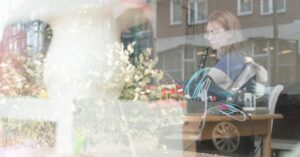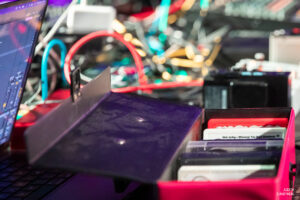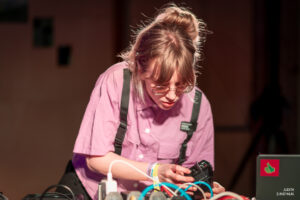Interview Series: [F]luisteren with Kaðlín Sara Ólafsdóttir
[F]luister is excited to present a series of musician’s interview, creating a channel for the continuous communication between musicians and audiences, and promoting a deeper understanding of music and discovering of new music/musicians. And we are happy to introduce you to the talented musician and composer, Kaðlín Sara Ólafsdóttir. She will perform at the next Fluister edition on 14th of September.
“Sound collector, harmony of layered sounds like our memories”

(Picture 1) Kaðlín Sara Ólafsdóttir, photo provided by Kaðlín
Eight years ago, Kaðlín Sara Ólafsdóttir moved from Iceland to The Hague for her study at the Royal Conservatoire.
During her studies she released her debut ‘Hljóðfirring’ (Icelandic for sound alienation) on a nostalgic cassette tape.
We meet her on a sunny afternoon to listen to her story about creating music, Sonology, nostalgia and home.
Fluister(F): We’re curious to learn more about your journey. Why did you move from Iceland to the Netherlands?
Kaðlín(K): Finishing high school, I found myself at a crossroads and had no clue about my academic path. My parents, both teachers, encouraged me to pursue higher education. During this time, a close friend who was studying classical music at the Royal Conservatoire of The Hague introduced me to a field called ‘Sonology’.
Until then, my musical experiences had been confined to playing the clarinet in a local marching band, a common path for Icelandic youth to learn how to play a music instruments. While I wrote pop songs in my bedroom, I hadn’t seriously considered a music career as classical clarinet player. Discovering Sonology felt like finding a missing piece and offered me the perfect opportunity to explore this new path. So I decided to move to The Netherlands for my study.
Recently I have finished my master study and graduated at the Royal Conservatoire. Even though I’ll eventually return to Iceland one day, I still want to stay in The Netherlands a little longer to explore my new challenge as a musician/composer. Meanwhile, my friend who introduced me to ‘Solonogy’, moved back to Iceland and is teaching music and conducting a school marching band.
F: What is ‘Sonology’?
K: ‘Solonogy’ is the scientific study of sound. It’s an interdisciplinary field that combines music, acoustics, electronics, and composition programming.I like to layer, change and alienate sounds. How sound is changed by playing, editing and recording. All together this sound tells you a story.
F: What do you focus on your work in terms of Sonology? Your study is influenced to your music?
K: My bachelor’s degree at the Royal Conservatoire was specialized in using recorded cassettes. Over the years, I’ve amassed a collection of a few hundred cassette tapes, discovered at flea markets, recorded it by myself or gifted by friends, etc. It is my treasure collection of sounds: field recordings, spoken letters, Dutch language, speech and many others.
My performances often feature a collection of cassette tapes, which I use as a sonic journey. By randomly selecting and playing these tapes, I introduce an element of chance and surprise. I never know what sounds are hidden in the tapes and will emerge. One unforgettable performance in a church. When I pushed the play button of cassette player, an unexpected sound of baby cry came out. These unpredictable moments are a fun aspect of my live shows.
I also rediscovered my clarinet, finding the ways to incorporate its into my compositions. I love the mix of layered sounds with the acoustic instrument. My compositions often begin with a melody, which I then develop by layering synthesizers, clarinet, and even vocal samples.
I aim to evoke a sense of nostalgia and homecoming through my music. It’s essential that my audience connects with these emotions as deeply as I do. To deepen the connection with Dutch audience, I incorporate Dutch vocal recordings in my show.

(Picture 2) Kaðlín Sara Ólafsdóttir, photo provided by Judith Zandwijk
F: Why nostalgia? Why home is important for you? Because you have been living in The Netherlands as a foreigner?
K: During the Corona pandemic, I made cassette tapes at home in Iceland. It had been a while since I’d stayed in Iceland for such long time, after leaving for the Netherlands. I stayed at my parents’ summer house and felt a sense of home, family, and things I had long forgotten. Of course, The Hague is now another kind of home for me.
When I perform live, the cassette tapes hold memories and evoke nostalgia, which is a core element of my music. Nostalgia was a major theme in my bachelor and master research as well. Ultimately, it’s about returning to nostalgia, capturing specific moments in your life.
Sounds are the building blocks of these life moments, and composing new music involves blending these elements. Pop music often draws inspiration from the 80s, creating a bridge between the past and the future. I’m interested in composing music that evokes nostalgia, using instruments to craft these emotional soundscapes.
F: The three tracks on your album, “Hljóðfirring,” features your haunting vocals. It feels like a recurring mantra. What are you singing about?
K: The vocals on the three track of “Hljóðfirring” are in Icelandic, no specific meaning or lyrics. It starts questions like, If I am here, will you still be there?” and “Where are we?” I respond to these queries through sung: “I’m here,” “I see you here,” and “I found you here.” However, the lyrical content is less about the literal meaning of the words and more about the sonic qualities of the Icelandic language. Like Sigur Rós, I am weaving the sound of the words.
F: What kind of music do you want to explore in the future?
K: I am still exploring the themes and sounds “Hljóðfirring”. This album has been released two years ago and was the result of my masters. I am playing these songs totally different now, because I’ve been drawn to softer, more ethereal soundscapes. The songs evolved by layering multiple melodic lines, creating a rich tapestry of improvisation.
I’ve been trying to translate these elements into live performances, arranging and structuring the spontaneous soundscapes into a coherent whole. Combining clarinet, cassette tape, and other instruments, I’m aiming for a delicate balance of sounds, avoiding overwhelming the listener. While I’ve maintained a consistent thematic and atmospheric approach, my compositional process has evolved.
Collaborating live with Toby Kruit has been invaluable. His involvement in the compositional process has broadened the musical landscape. Our musical conversations, marked by chance, tension, and flowing melodies, create a dynamic and unpredictable energy. We’ve studied ‘Sonology’ together, and after he mastered my album, I realized the potential for a deeper musical partnership. As I don’t play a piano, I’ve asked Toby to contribute keyboard elements, creating a more engaging live performance.
By incorporating modular synthesizers and sampling, we can push the boundaries of live improvisation, generating fresh melodies and creating a more dynamic and exciting show. As Toby’s role in the compositional process grows and our live performances deepen, we’re exploring new artistic directions together.
F: What kind of sonic journey can the audience expect at Fluister show?
K: Emerging from nostalgia, a sense of home is found. I invite you to enter my musical space.
F: Thanks for your time and interview. Looking forward to seeing you at Fluister.
K: Thank you. See you at the Fluister show.

(Picture 3) Kaðlín Sara Ólafsdóttir, photo provided by Judith Zandwijk
Article by Su-Young Kim
copyright@Fluister.org